
Most of the talk about renewable energy is aimed at electricity production. However, most of the energy we need is heat, which solar panels and wind turbines cannot produce efficiently.
To power industrial processes like the making of chemicals, the smelting of metals or the production of microchips, we need a renewable source of thermal energy. Direct use of solar energy can be the solution, and it creates the possibility to produce renewable energy plants using only renewable energy plants, paving the way for a truly sustainable industrial civilization.
The missing element in our sustainable energy strategy is a renewable source of heat energy
A large share of energy consumed worldwide is by heat. Cooking, space heating and water heating dominate domestic energy consumption. In the UK, these activities account for 85 percent of domestic energy use, in Europe for 89 percent and in the USA for 61 percent (excluding cooking).
Heat also dominates industrial energy consumption. In the UK, 76 percent of industrial energy consumption is heat. In Europe, this is 67 percent. I could not find figures for the US and for the world as a whole, but these percentages must be similar (and probably even higher on a worldwide scale because many energy-intensive industries have been outsourced to developing countries). Few things can be manufactured without heat.
Solar panels and wind turbines are no producers of heat energy
The importance of heat in total energy consumption sharply contrasts with our efforts to green the energy infrastructure. These are largely aimed at renewable electricity production using wind turbines and solar panels. Although it is perfectly possible to convert electricity into heat, as in electric heaters or electric cookers, it is very inefficient to do so.

It is often assumed that our energy problems are solved when renewables reach ‘grid parity’ - the point at which they can generate electricity for the same price as fossil fuels. But to truly compete with fossil fuels, renewables must also reach ‘thermal parity’.
Though today in some locations it may be as cheap to produce electricity with wind or solar energy as with gas or coal, it still remains significantly cheaper to produce heat with oil, gas or coal than with a wind turbine or a solar panel. This is because it takes 2 to 3 kWh of fossil fuel thermal energy to create 1 kWh of electricity, so it is at least 2 to 3 times cheaper to make heat by simply burning the fossil fuels directly than to use an electric renewable technology at grid parity.
Manufacturing wind turbines and solar panels requires heat
This means that solar panels and wind turbines will have to become two to three times cheaper than they are today in order to reach thermal parity with fossil fuels. This might sound reasonably possible, especially if you expect fossil fuel prices to rise. But consider this: even though they are intended to replace fossil fuels, renewable energy sources like wind turbines and solar panels are in fact dependent on a continuous supply of fossil fuels.
Solar panels and wind turbines do not need fossil fuels to operate, but they do need fossil fuels for their production. You won’t find any factory manufacturing PV solar panels or wind turbines using energy from their own PV solar panels or wind turbines. Why not? Because it would be 2 to 3 times more expensive to generate heat with solar panels or wind turbines than with fossil fuels. Yet to make solar panels and wind turbines, to produce steel and silicon for instance, heat is what is most needed. This means that the production costs of solar panels and wind turbines will be affected negatively by rising fossil fuel prices.
You won’t find any factory manufacturing PV solar panels using energy from their own PV solar panels, because it would be 2 to 3 times more expensive to generate the heat required for producing steel and silicon
The same goes for batteries, which are an essential element of electric cars and renewable electricity storage, and for many other modern green technologies, like LEDs and heat pumps. They require heat for their production, and this heat can be delivered at least 2 to 3 times cheaper by burning fossil fuels than by using wind turbines or solar panels (cheap electricity from hydropower plants is also an option, but has limited potential). This is a fundamental problem, because we will have to produce new wind turbines and solar panels every 20 to 30 years, and new batteries every 5 to 10 years.
Renewable source of heat energy
The missing element in our sustainable energy strategy is a renewable source of thermal energy. Geothermal energy produces heat, but its potential is limited to regions that have volcanoes. Biomass is another option, but it faces many problems. If we were to try to provide an important share of heat demand by burning biomass, we would quickly come up against the limits of what the planet can produce. There is only one source of heat energy left, and it is a powerful and inexhaustible one: solar energy.

We tend to see solar energy as yet another way to generate electricity, using photovoltaic panels or solar thermal power plants. But solar energy can also be applied directly, without the intermediate step of generating electricity. Basically, harvesting direct solar energy can happen in two ways: by means of water-based flat plate collectors or [evacuated tube collectors](http://en.wikipedia.org/wiki Solar_thermal_collector#Evacuated_tube_collectors), which collect solar radiation from all directions and can reach temperatures of 120 °C (248 °F), and by means of solar concentrator collectors, which track the sun, concentrate its radiation, and can generate much higher temperatures.
These can be parabolic trough systems, linear concentrating Fresnel collectors, parabolic dish systems or solar power towers. Almost all of these technologies were developed at the turn of the 20th century.
Solar thermal power versus solar thermal heat
The problem is that we mostly use this technology for the wrong purpose. In today’s solar thermal plants, solar energy is converted into steam (via a steam boiler), which is then converted into electricity (via a steam turbine that drives an electric generator). This process is just as inefficient as converting electricity into heat: two-thirds of energy gets lost when converted from steam to electricity. This is one of the main reasons why the use of solar thermal energy to produce electricity is only cost-effective in deserts.
If were to use concentrated solar power to generate heat instead of converting this heat into electricity - a process in which two thirds of energy gets lost - the technology would be cost-effective anywhere on Earth
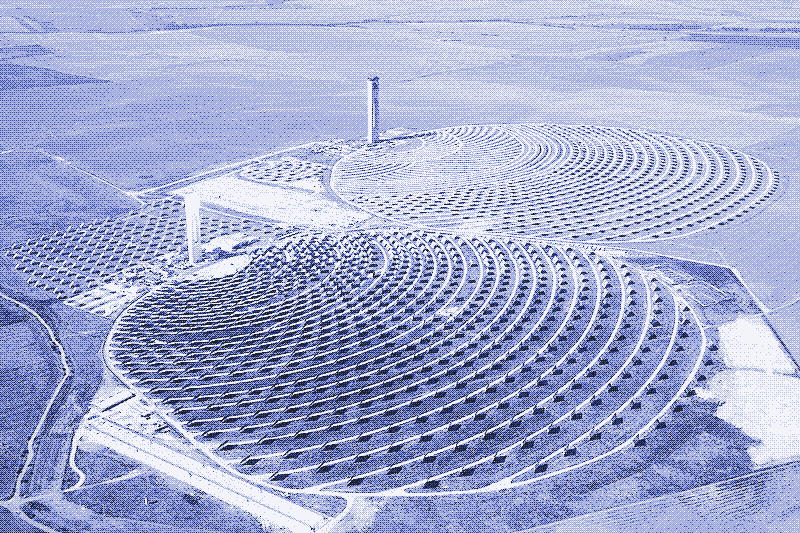
If we were to use solar thermal plants to generate heat instead of converting this heat into electricity, the technology could deliver energy 3 times cheaper than it does today and become cost-effective also in less sunny regions. The crucial difference between solar thermal electricity and other renewables producing electricity is that solar thermal actually starts with heat energy. Thus, contrary to other renewables, the cost of heat energy using the technology is far lower than the cost of electricity, and so it can compete with burning fossil fuels at the thermal level.
Low temperature solar heat
This can be demonstrated by flat plate collectors and evacuated tube collectors, which are used for domestic hot water preparation and (to a lesser extent) interior space heating. This technology is used without any conversion losses and is cost-competitive with fossil fuels almost anywhere on Earth. According to the 2011 update of the International Energy Agency’s Solar Heating and Cooling Programme (IEA-SHC), solar thermal heat is now the second most important renewable energy source following wind, and a much more important energy source than photovoltaics and solar thermal power plants. Almost 60 percent of solar thermal heat capacity can be found in China and another 20 percent is in Europe. The US and Canada (where the main application is to heat swimming pools) account for less than 9 percent.
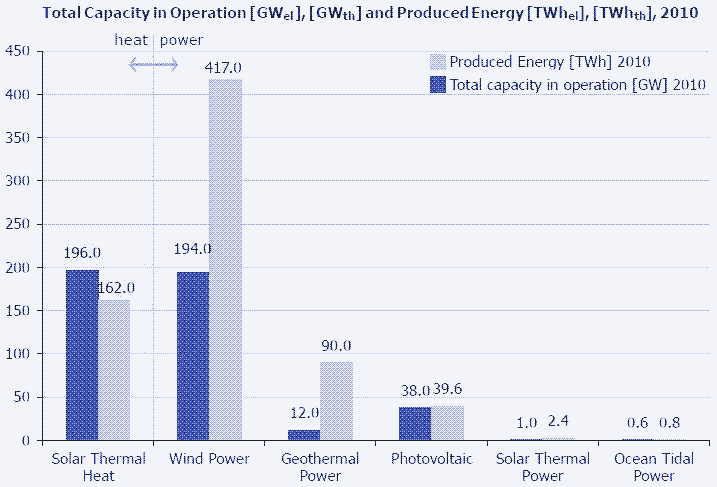
Sweden, Denmark, Spain, Germany and Austria have the most sophisticated markets for different solar thermal applications, including large-scale plants for district heating and a small but growing number of systems for air conditioning and cooling (using an absorption chiller). By the end of 2009, 115 solar supported district heating networks and 11 solar supported cooling systems were installed in Europe. Canada, Saudi Arabia and Singapore have also built a few large-scale solar heat systems for producing hot water, space heating and cooling.
The potential of solar heat for industrial processes
Without a doubt, solar heat for domestic purposes should continue to be encouraged and a lot of potential remains. But it does not stop there. According to a 2008 report (pdf), which analyses the situation in Europe, the potential for solar heat in industrial processes is even larger than in the domestic market. About 30 percent of industrial heat demand in Europe is below 100 °C (212 °F), which could be delivered by commercially available flat plate collectors (< 80 °C) and evacuated tube collectors (< 120 °C) currently used for domestic purposes.
Almost 60 percent of heat demand in Euopean industry could be covered by already available and cost-effective technology using an inexhaustible renewable energy source that has no ecological disadvantages whatsoever.
Another 27 percent of industrial heat demand requires medium temperatures (100 to 400 °C or 212 to 752 °F), which could be reached by improved versions of these collectors (up to 160 °C, see this document) and by commercially available solar concentrator technologies now mostly used for electricity production: parabolic troughs, parabolic dishes and linear concentrating Fresnel collectors.
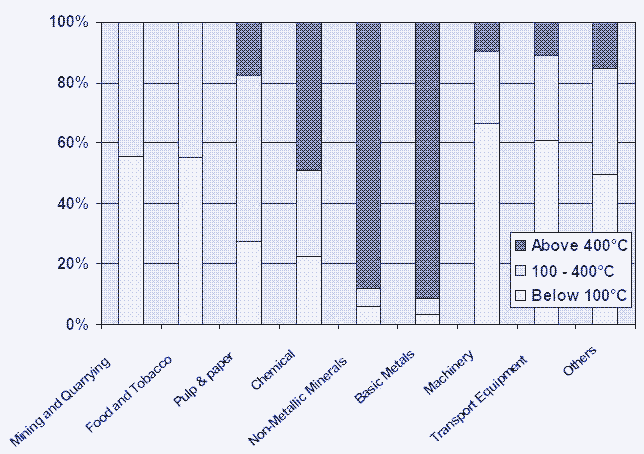
This means that at least 57 percent of heat demand in European industry (or almost 40 percent of total industrial energy demand) could be covered by available and cost-effective technology using an inexhaustible renewable energy source that has no ecological disadvantages whatsoever. The capital costs (and embodied energy) of this would be much less than replacing a similar amount of fossil fuel energy use with solar panels or wind turbines. And of course, it could be done anywhere, not just in Europe.
Solar heat in industry: existing applications
At low and medium temperatures, solar heat can be used for industrial processes in several ways. It can provide warm water for processes like bottle washing or chemical processes. Secondly, it can provide hot air for drying and baking processes, for instance in the food and paper industries. Thirdly, it can generate steam that can be fed into steam heat distribution networks, which are widely used in many industries. The interesting thing is that in all these applications, the existing industrial machinery and distribution infrastructure remains in place. Only the energy source is replaced.

Some manufacturers have started marketing their solar concentrator technologies for the use of heat generation in industry, in addition to their application as electricity generators. Examples are Sopogy (a Hawaian company that sells modular parabolic trough systems - image above), the Solar Power Group (a German company that sells linear concentrating Fresnel collectors) and HelioDynamics (an American seller offering similar technology - image below).

Installations for the use of solar industrial process heat are still rare, but they exist. German heating systems manufacturer Viessmann installed 260 m² of its own flat plate collectors on its factory in France to provide hot water for a chemical process, taking a first step towards producing renewable energy using renewable energy. A solar thermal plant based on 1,900 m² of parabolic troughs provides steam for a pharmaceutical plant in Egypt.
A similar solar thermal plant was built for a dairy plant in Greece. A food processing facility in California has 5,000 m² of parabolic troughs to produce steam used in the manufacturing process. Several industrial applications of solar heat have been built in India, using both flat plate collectors and concentrator technologies.
At low and medium temperatures, solar heat can be applied to industrial processes using already existing machinery and heat distribution pipelines
A solar concentrator system called ARUN - a Fresnel parabolic reflector with point focus that delivers temperatures from 80 to 400 °C - has been installed in six industries, ranging from a dairy plant to an automobile manufacturer (picture on the left). India also has several large solar cooking facilities for community kitchens (schools, hospitals, factories, religious centres).

The largest one consists of 84 parabolic dish systems reaching temperatures of up to 650 °C and producing up to 38,500 meals per day. The largest solar process heat application to date was recently installed in Hangzhou, China, where 13,000 m² of solar collectors on the roof of a textile factory provide hot water for a dyeing process.
The Global Solar Thermal Energy Council is continually updating its list of new industrial applications of solar heat.
Renewables building renewables
The remaining 43 percent of industrial heat demand in Europe is above 400 °C (752 °F). These include many of the industrial processes that we need to manufacture renewable energy sources (wind turbines, solar panels, flat plate collectors and solar concentrators) as well as other green technologies (like LEDs, batteries and bicycles). Examples include the production of glass (requiring temperatures up to 1,575 °C) and cement (1,450 °C), the recycling of aluminum (660 °C) and steel (1,520 °C), the production of steel (1,800 °C) and aluminum (2,000 °C) from mined ores, the firing of ceramics (1,000 to 1,400 °C) and the manufacturing of silicon microchips and solar cells (1,900°C ).
Solar furnaces can reach temperatures up to 3,500 °C (6,332 °F), enough to produce microchips, solar cells, carbon nanotubes, hydrogen and all metals
These temperatures can be achieved by solar concentrator technology. Linear reflectors (parabolic trough systems and linear concentrating Fresnel collectors) are limited to temperatures of about 400 °C, but point concentrators can reach higher temperatures. These include parabolic dish systems, solar power towers, and solar furnaces - which are basically a combination of power towers and parabolic dish systems.
Solar furnaces can produce temperatures up to 3,500 °C (6,332 °F), enough to manufacture microchips, solar cells, carbon nanotubes, hydrogen and all metals (including tungsten which has a melting point of 3,400 °C). These temperatures can be achieved in just a few seconds - see this short video of a solar furnace melting steel. The most powerful solar furnace is the one at Odeillo in France, built in 1970, which concentrates the light of the sun 10,000 times and has a power output of 1 MW.
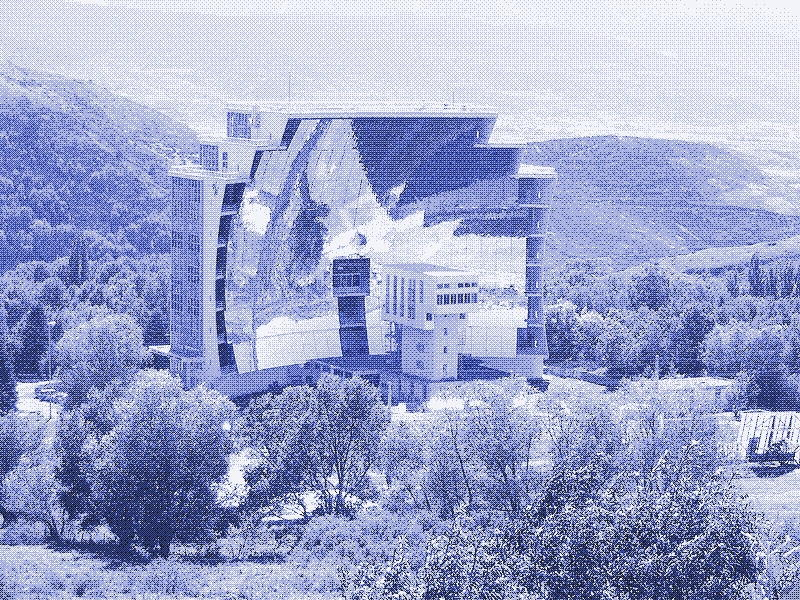
More than 60 heliostats (only one is seen on the picture above, in the lower righthand corner) direct the rays of the sun onto a parabolic mirror of more than 1,800 square metres, from which they are concentrated on a focal point with a diameter of only 40 centimetres in the tower in front of it. A similar solar furnace stands in Uzbekistan, built in 1976, but it is slightly less powerful due to lower solar insolation in the region. The picture below shows it in action, melting metal.

You don’t need such an enormous structure to achieve high temperatures. Several smaller solar furnaces have been built, often using only one heliostat. They reach similar or only slightly lower temperatures (usually between 1,500 and 3,000 °C) than the giants pictured above, though at significantly lower power outputs (between 15 and 60 kW). They can perform most of the same processes as the large solar furnaces, but processing smaller amounts of materials or chemicals.
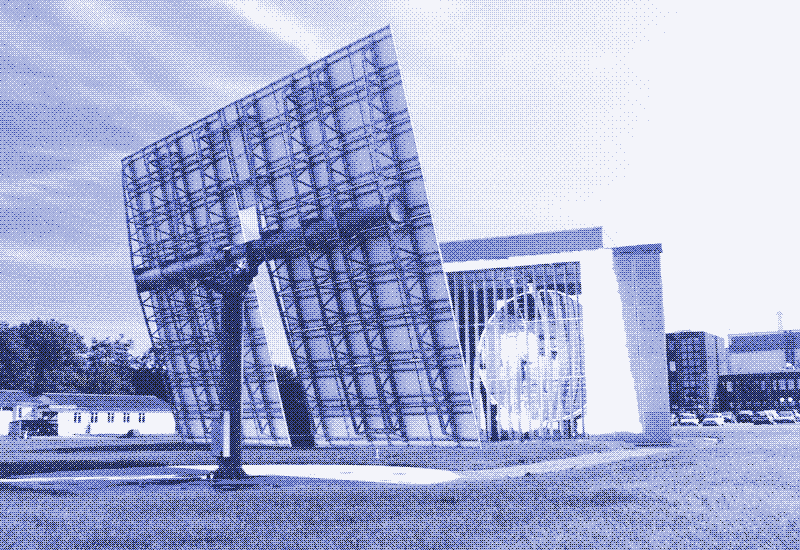
Examples of smaller solar furnaces can be found at the Paul Scherrer Institute in Switzerland (pictured above), the National Renewable Energies Laboratory in the USA, the Plataforma Solar de Almería in Spain, the German Aerospace Center in Germany, and the Weizmann Institute of Science in Israel (a solar power tower). They have concentration ratios between 4,000 and 10,000. In solar concentration, the temperature is proportional to the degree of concentration, whereas power will be proportional to size and efficiency (which is mostly determined by temperature).
Solar energy improves product quality
Solar furnaces not only have the potential to replace fossil fuels for the energy-intensive production of construction materials, chemicals, and high-tech products like microchips and solar cells, but they also offer additional benefits because of their pure combustion and selective heating capacities. A 1999 research paper describes the manufacturing of silicon solar cells using a solar furnace, concluding that “solar furnace processing of silicon solar cells has the potential to improve cell efficiency, reduce cell fabrication costs, and also be an environmentally friendly manufacturing method. We have also demonstrated that a solar furnace can be used to achieve solid-phase crystallization of amorphous silicon at very high speed.”
As opposed to low and medium temperature processes in industry, where only the energy source is replaced and the machinery and distribution infrastructure can remain in place, most high temperature solar heat applications require new machinery. Furnaces and kilns have to be rebuilt. Some efforts have been made. The Paul Sherrer Institute in Switzerland designed several solar powered lime and cement kilns (pdf), and research concluded that they could become cost-competitive with a fossil fuel powered kiln (pdf) following some further technological improvements. Again, the quality of the product turned out to be better using solar energy, eliminating combustion by-products.
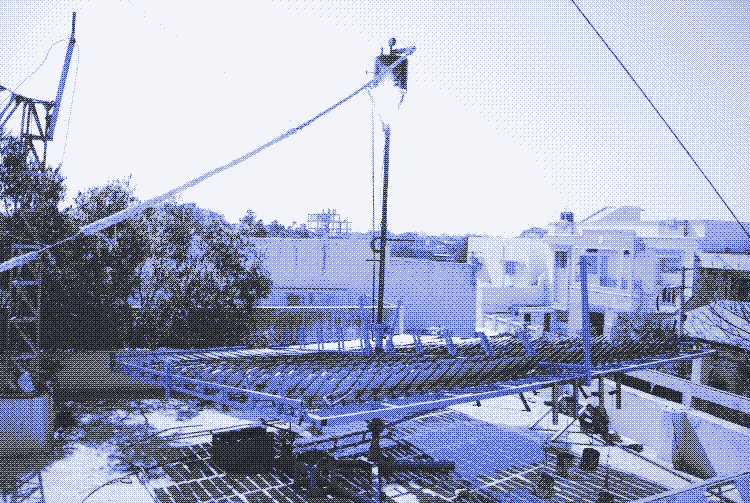
Though existing solar funaces prove that anything could be produced using direct solar heat instead of fossil fuels, this is not yet possible in a cost-effective way (it is cheaper to use fossil fuels). However, since solar furnaces could produce all materials needed to build more solar furnaces, they might become cost-effective even without technical improvements if fossil fuels become more expensive.
Moreover, the capital costs of solar concentrators are decreasing quickly following some recent innovations aimed at simplifying the technology. These might not only lead to cheaper high temperature solar heat concentrators in the future, but they also make the use of solar heat for medium temperatures more affordable and competitive today.
The most spectacular example is the Solar Fire P32 (picture above and pictures below), a solar concentrator developed in 2010 by the French NGO the Solar Fire Project. It is an open source design (joining forces with the Open Source Ecology project), but the machine can also be bought for 7,500 euro dollar - less than the price of an urban wind turbine.
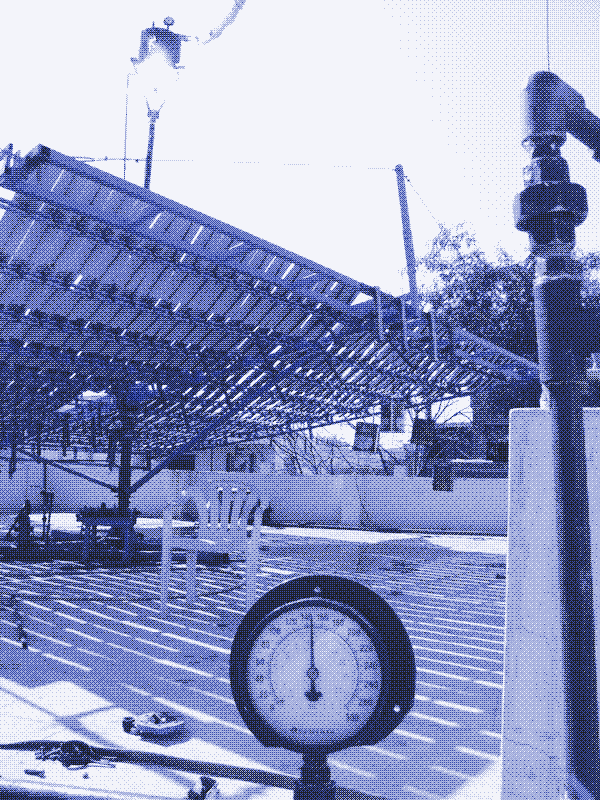
Solar Fire P32 is built using simple, abundant and non-toxic materials. Contrary to most other modern green technologies, there is no need for rare earth metals or advanced tools that are not found in an average metal workshop. Essentially, this is a renewable source of heat energy analogous to home made windmills used to produce mechanical energy.
The machine can deliver up to 15 kW and can reach a focal temperature of 700 °C (1,292 °F), enough to melt (and thus recycle) aluminum, the material that is used to make its reflectors. This means that you could use a Solar Fire P32 to make another Solar Fire P32. Or almost. The receiver and the supporting structure are made of steel, which requires a higher melting temperature to recycle. However, the structure could as well be made of wood, basketry or aluminum, and the steel receiver could easily be scavenged material. The use of glass improves the workings of the device, but is not strictly necessary.
The Solar Fire P32 costs 7,500 dollar and can be used to make another Solar Fire P32
The Solar Fire P32 is composed of 360 small mirrors with a total surface of 32 square metres, focusing sunlight on a steam boiler above them. The steam can be used directly to purify large quantities of water, boil milk, produce edible oils, make charcoal, bake bricks, make paper, and so on.
Increasing energy autonomy
The steam can also drive a steam engine to directly power a water pump, oil and grain mills, cotton spinning, or any other stationary application requiring mechanical power. Connected to a steam generator, the machine can also generate electricity (up to 3 kW). These two last applications involve conversion losses, but they are interesting additions for those who want to achieve energy independence, especially in regions where there is lots of sun but no wind. The machine can produce heat, electricity and direct mechanical energy.

The Solar Fire P32 is - in the first place - aimed at developing countries and designed to be cost-effective compared to burning coal and wood, reducing deforestation and pollution, increasing energy autonomy, and providing an energy source at the scale of traditional practices and small industries. It has been built in Mexico, Cuba, Burkina-Faso, Mali, India and Kenya, but also in Texas, France and Canada. Obviously, the design could also be useful in the developed world, where the supply of fossil fuels might not remain as easily accessible as it is today.
Simplifying technology
Apart from the additional equipment that is required to generate electricity, conventional solar concentrator technologies demand heavy capital investments for several reasons. Parabolic trough systems and parabolic dish systems require curved mirrors that are expensive to produce. Moreover, these mirrors cannot be manufactured locally and often have to be transported over long distances, increasing costs further. In both systems the curved mirrors are large and heavy, requiring rigid frames, strong foundations, powerful hydraulics and sophisticated tracking systems to follow the sun. In parabolic dish systems, the heat engine or steam boiler is part of the moving structure, increasing weight and thus making things even worse.
Solar power towers - which were invented in 1878 - solve some of these issues: they use nearly flat mirrors and all mirrors share one stationary receiver. But, they require the construction of a large tower building. Last but not least, all of these systems have very high land requirements because of overshadowing issues. Linear Fresnel concentrators use (mostly) flat mirrors, have simpler tracking systems and are more compact, but they can only reach temperatures of 250 °C (using relatively low-tech materials) or 450 °C (using sophisticated technology).
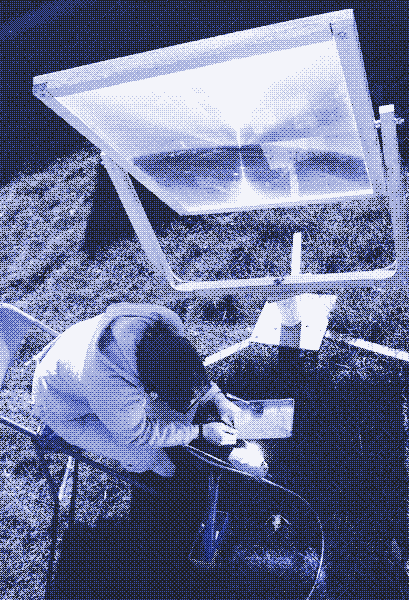
The Solar Fire is a Fresnel parabolic reflector with point focus, just like ARUN - but unlike that machine it is placed horizontally and the receiver does not have to be turned together with the mirrors, resulting in light weight and high wind resistance. The machine uses slightly curved mirrors, achieved by mechanical bending which can be done on the spot. Sun tracking of the mirrors is done by hand, eliminating the need for electronics and electric motors altogether (multiple mirrors can be turned at once using hand operated wheels). This might sound crude, but for industrial applications the machine has to be supervised anyway.
And because it is open source, it can be further improved by anyone. Eerik Wissenz, the designer of the machine, thinks this is the only way: “Companies pursuing patents for solar collectors have fallen into a complexity trap. Since solar energy is free it is far simpler to add 5 percent more surface area instead of creating complex machines too expensive to be commercially viable. Solar fire concentration is so simple it cannot be patented.”
Low-tech solar furnaces
High temperature solar furnaces can be low-tech autonomous systems, too. One example is the large magnifying glass used by Sundrop Jewelry, which reaches high enough temperatures to melt coloured bottle glass into handcrafted jewelry. Of course the power output is low, making this installation useless if you want to produce industrial quantities of glass. But it shows that solar heat can be used on any scale.

Markus Kayser, in which glass is produced using only sunlight and desert sand. I would like to quote the artist here: “Whilst not providing definitive answers, this experiment aims to provide a point of departure for fresh thinking”.
Energy Storage
How can you power factories using an energy source that is not always available? Solar insolation varies throughout the day and the seasons, and there is no sun at night. Moreover, solar concentrator technologies only work with unscattered sunlight, which means that a passing cloud stops energy production. This raises two questions. Some industrial processes work fine with intermittent energy supply, but how do you guarantee an uninterrupted supply of energy to a process that requires it? And what do you do when there is no sun at all for a week?
Storing heat is much cheaper and more efficient than storing electricity in a battery
There are three ways to deal with the intermittency of solar power. The first solution is to design hybrid systems: make solar and already existing energy sources work together. This is how most of today’s solar thermal power plants work. In this scenario, which offers a solution for both short and long term storage, industrial processes are powered by solar heat whenever it is available. When it is not, solar energy is instantly replaced by fossil fuels or electricity. It is not an ideal solution, but it could save large amounts of energy. And we don’t need new technology to make it work.
The second strategy is to store solar energy so that it can be used to smooth out industrial processes (analogous to a flywheel for smoothing out mechanical processes) and to guarantee energy supply on cloudy days or at night. Storage of heat is much cheaper and more efficient than storage of electricity. The most low-tech way is to store heat in well-insulated water reservoirs - another technology that is more than 100 years old.
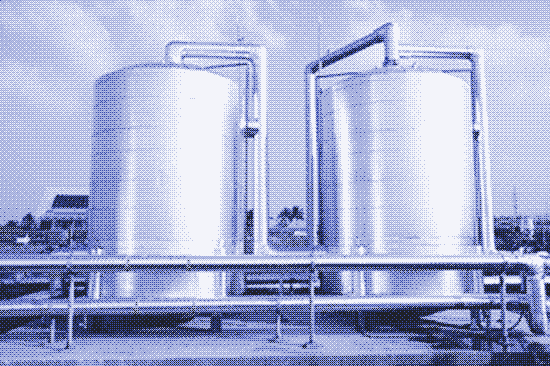
The disadvantages are that you need quite a lot of space, and that water storage only works up to a temperature of 100 °C (212°F). There are more compact ways to store heat at higher temperatures, for example by using ceramics or phase-changing materials (certain salts). These storage media are already used in one solar thermal power plant, but they would be even more efficient if used in a thermal only system. Innovative technology could further improve heat storage.
Postponing work instead of storing energy
The third way to deal with the intermittency of solar heat is to store work instead of energy. We let our factories work when the sun shines, and only when the sun shines. Just like we wait for a sunny day to do the laundry, we could wait for a sunny day to bake bricks, recycle metal or produce smartphones. Industrial production would be concentrated in summer months. Of course, there is a price to pay. Industrial production would be lower. But considering the fact that our energy and environmental problems are largely caused by overproduction and overconsumption of goods, this is not as far-fetched as it might seem.
Combining all three strategies could be a solution. In that scenario we would run part of our factories only when the sun shines (and when the wind blows), using heat storage, fossil fuels, biomass or electricity to smooth out industrial processes if necessary. Critical goods could be produced continuously combining solar heat and heat storage, fossil fuels, or biomass. Of course, not all climates are blessed with enough sun to make solar heat a viable option to power the whole industry. But since many people are now talking about outsourcing electricity production to desert regions, we could just as well move our factories to regions where there is plenty of sun. It is much more efficient to transport manufactured goods over large distances than to transport electricity.
Solar powered enhanced oil recovery
As always, a sustainable technology can be used for unsustainable purposes. Solar heat is a great way to get more oil out of fields that are now considered exhausted. Getting that remaining oil out using gas would cost more money and energy than the oil could return, but using a free source of energy changes everything.

At least one company specializes in this application. Glasspoint, a US firm originally founded to use solar heat for drying gypsum wall board, has seen remarkable growth promoting “Solar Enhanced Oil Recovery”.
This has been tried before, but they use an innovative technology: parabolic trough mirrors suspended from the ceiling of enormous glasshouse structures that are equipped with robotic cleaning systems. Because they are protected from wind, sand and dust by the greenhouse, the mirrors can be made extremely light and without protective glass layers - lowering their costs and increasing their efficiency. The steam that is generated by the solar heat is pumped into the oil reservoir. The more sun there is, the more oil will come to the surface. Only 20 to 40 percent of an oil field can be recovered using standard techniques, but as much as 60 to 80 percent can be recovered using solar heat. In the end, solar heat could thus increase fossil fuel production and CO2-emissions.
Sources, inspiration & more information:
- The thermal problem and the solar (thermal) solution, Eerik Wissenz, 2011.
- Concentrating Solar Concentrators at the Build it Solar Site. Lots of links to DIY-projects. Thanks to Paul Nash.
- High temperature solar collectors, Robert Pitz-Paal, in ‘Solar Energy Conversion and Photoenergy Systems’.
- Direct Use of the Sun’s Energy!", Farrington Daniels, 1964.
- Task 33 - Solar heat for industrial processes, Solar Heating and Cooling Programme, International Energy Agency.
- Potential for Solar Heat in Industrial Processes (pdf), Claudia Vannoni, Riccardo Battisti and Serena Drigo, Task 33
- Process Heat Collectors - state of the art within task 33/IV (pdf), Werner Weiss and Matthias Rommel
- Solar thermochemical process technology, Aldo Steinfeld & Robert Palumbo, 2001
- Solar Heat Worldwide 2011 (pdf), SHC, Werner Weiss & franz Mauthner, may 2011
- The Value of Concentrating Solar Power and Thermal Energy Storage, National Renewable Laboratory, 2010
- Understanding solar collectors, George Kaplan, 1985
- Global Solar Thermal Energy Council.
- So-Pro: European project on solar process heat
- European Solar Thermal Industry Association
- The European Alliance SolLab
- SolarPACES
- CSP- how it works
Reactions
To make a comment, please send an e-mail to solar (at) lowtechmagazine (dot) com. Your e-mail address is not used for other purposes, and will be deleted after the comment is published. If you don’t want your real name to be published, sign the e-mail with the name you want to appear.
Reactions
Kris De Decker
@ Matthias: corrected.
Jan@Bytesmiths.com
Great posting!
I’ve often had to put up with people who asked, “How many solar panels do I need to run my electric baseboards, hot water heater, and hot tub.”
Sometimes, I just don’t know how to respond to such comments.
Heat is a low grade of energy; electricity is a high grade of energy. They each have their need and appropriate sources, which you’ve summarized very well here.
Andrew
Another excellent article - it should prompt more thinking about energy quality along with energy quantity. I think that our current energy systems provide such an extravagant supply in the developed Western world that we have somewhat lost a nuanced sense of energy application. This article is especially good when combined with your essays on pedal powered technology for mechanical (versus electrical) outputs.
Jim
Kris, thanks for the enlightening post - I work in the solar industry and try to follow diligently the options available, but still have missed number of these. I suspect you may already be aware of it, but if not, you might be interested in a company called Cogenra. As the name suggests, it’s a cogen system (solar), and while it’s proprietary and definitely still high tech, I believe it’s compelling. YMMV, keep up the great work
Mark
What about using a heat pump coupled with solar photovoltaic or wind? This works pretty well for heating living spaces, since the temperature differential required is not that great. However it’s obvious that we can capture more thermal energy from a given area of sunlight than we can electrical energy with current technology.
There are solar panel factories that run on the power of their own solar panels, and there is no technical reason why more intensive processes (like aluminium smelting) couldn’t be run off the sun (either thermally or via photovoltaic) - it’s only an issue of cost and raw material availability.
Joe V.
Mention should be made of another approach to low-tech solar concentration, which is the so-called infinitely large solar furnace using a grid of small, flat mirrors, each aligned so as to form, in affect, a fresnel mirror panel. Here’s one such example, which can easily be adapted on a small scale for use as a solar stove (concentrating sunlight onto the bottom of a cast-iron skillet), or other similar application:
http://www.eskimo.com/~billb/amateur/mirror.html
Made larger, these panels can be used to generate extremely high temperatures, useful for the types of industrial applications mentioned in the article.
I made a small version of this concentrator, starting with a box of 12" mirrored tiles purchased at a local hardware store, cut into 2" squares using a simple glass cutter, the mirrors mounted to a simple perforated masonite panel using the method described in the above link, such that each can be adjusted to focus its light onto the common focal point of the panel.
~Joe V.
Bloss
A generally good article on solar power and factories, but some basic errors of fact (or at least emphasis) which could easily have been checked using a search engine.
For example it says:
“Though today in some locations it may be as cheap to produce electricity with wind or solar energy as with gas or coal, it still remains significantly cheaper to produce heat with oil, gas or coal than with a wind turbine or a solar panel. This is because it takes 2 to 3 kWh of fossil fuel thermal energy to create 1 kWh of electricity, so it is at least 2 to 3 times cheaper to make heat by simply burning the fossil fuels directly than to use an electric renewable technology at grid parity.”
I note – this true ONLY if pollution and environmental damage is allowed to remain uncosted into the price!
The current price regimes for fossil fuels of all types include no value for damage already done to the environment at a local let alone a global level and does not include a value for damage being done right now. So there is a 300-year debt to be recovered and that debt is still being incurred until we price fossil fuels to account for the externalities inherent in their extraction and use. The price regimes also take no account of long term scarcity – our economic system assumes that resources are infinite (by assuming that as one resource diminishes, and so the price therefore increases, more of the same resource will be found (as the higher price makes it ‘more cost effective’ to use lower grade or less easily accessible resources). That economic thinking also says that if one resource is exhausted entirely then another will always be found to take its place.
This is how humans have lived for eons – we stay in one place until what is available to sustain our lives is used up, or the waste we produce makes it unliveable (or often both) – then we simply move to a new place and start again. Of course we live on a finite Earth and are now finding that we can no longer do that – so we have no choice but to create an economic system to account for that, or modifying the economic system we have to not allow uncosted and uncharged for externalities – because in that finite closed system we live on we all pay in the end anyway!
A further example the article says:
“Solar panels and wind turbines do not need fossil fuels to operate, but they do need fossil fuels for their production. You won’t find any factory manufacturing PV solar panels or wind turbines using energy from their own PV solar panels or wind turbines.”
Again I note that this is simply not so – there are many, many PV panel factories using solely renewable energy including from roof top panels on the factories. These factories are also using various forms of renewable energy for process heat (< 400 degrees C). They are in Europe, USA, China, Brazil, India – you name it. Sure they are not the majority and there must be more, but your article says there are none.
There are a number of other errors of fact or emphasis or claims of ‘all’ or ‘none’ where it should be ‘some’, but I see no point in doing a point by point correction.
As I said, the mag is a good one, but this is poor research and journalism from what purports to be an ‘in-tune’ online source. If readers like me find errors that are as egregious as I think these are, then your credibility will take a hit. That’s the reason I raise my concerns – in the hope that it can help the mag improve.
Paul Nash
Thanks Kris, for yet another great article. With all renewables, when we start looking of an end use that matches the nature of the energy being produced, we will find more and more reasons to do renewables.
I have been particularly impressed with the approach of Solar Fire and Glasspoint. Solar Fire’s effort to eliminate a lot of unneccesary complexity, and produce something that can be built by almost anyone, anywhere is commendable - it allows communities, anywhere, to start to produce their own energy, and industry, instead of relying on imports.
The Glasspoint approach has focused on industrial customers, and they too have succeeded in eliminating a lot of high tech complexity, at the cost of a large greenhouse area. The performance specs are impressive - about 56% on the incoming solar energy is delivered as high temperature, high pressure steam. The application for steam assisted oil recovery, while maybe not the most eco-friendly application, is, from a functional point of view, an ideal use, as it does not need 24/7 steam, it just needs X GJ or BTU per day/week.
It has just been announced (8 Aug) that Glasspoint has won a contract with the government of Oman to build a four hectare, 7MW system, for steam assisted oil recovery.
This system can also be used for crop drying, seawater desalination, ethanol distillation, food processing, hospital heat and many other applications that use process steam.
Best hopes for appropriate solar solutions!
Ben
I’ve worked some in solar, and I think it’s true that many PV plants (including an older one of Evergreen’s in MA, now closed) have installed arrays, (sometimes mainly for testing), but I’ve never heard of a plant that generated even close to its net energy requirements onsite, let alone operated off grid. Other hand, wouldn’t surprise me at all if some manufacturer bought enough green credits from wind etc., to offset the carbon karma of their plant; IIRC there’s at least one brewery that does that, as part of a corporate image.
From a technical standpoint, that works fine up to double-digit penetration of unschedule-able renewable sources. Beyond that, we’ll have to figure out storage, whether physical or behavioral in nature - but as an engineer in the field, that’s a problem we’d love to have already.
This article prodded me to discuss a couple of engineering nits and a general gripe on the subject: http://fiveislandsorchard.wordpress.com/
Matthias
Very nice article. BUT Please edit your statement: You won’t find any factory manufacturing PV solar panels using energy from their own PV solar panels, because it is very inefficient (and thus utterly expensive) to convert electricity into heat
Converting electrical energy to heat is very efficient. Electrical heaters are comparable cheap and require low maintenance. Its just the electric energy which is costly and to valuable to waste it as heat. The efficiency loss is the part to generate electricity but not to convert electricity to heat.
José A. de Souza Jr.
A much more efficient use of concentrated solar energy would be in using it to gasify biomass in order to make syngas. Up to now gasification has been considered uneconomical (et pour cause!) basically due to the fact that a lot of feedstock must be burned to get some fuel. Not to mention the ensuing pollution. But central power towers and computer-controlled fields of sunshine-following mirrors can change that picture. Not only can clean electricity be obtained through renewable syngas in modern combined-cycle power plants but erzatz fuels like green diesel, gasoline and aviation fuel and nearly everything else currently derived from fossil oil and gas(http://www.sundropfuels.com/). Yes, there’s plenty of sunshine and biomass (including what we deem as “garbage”) to power modern industrial and more sustainable societies about anywhere on Earth.
Randy Childers
I’m greatly encouraged to see this article – personal DIY solar heating and power generation for the home is something I’ve been thinking about and working on as well. This definitely validates the effort.
http://www.cakefile.org/solar_hot_water.html
Baksa Péter
“Geothermal energy produces heat, but its potential is limited to regions that have volcanoes”.
Not necessarily, for example Hungary has a high geothermal gradient but no volcanoes.
It is accessible everywhere using heat pumps. Drawback is you need unefficient electricity to run a heat pump, but if you run it on solar power… There is less solar power during winter.
However I’m a bit skeptical about this, I don’t know what would happen if whole Europe would be heated by heat pumps, that would surely affect soil temperatures. Could you do an article on that?
Brian R. Earley
Run in vacuum to reduce heat….
Brian Robert Earley
Dave
And wait till you drink the coffee !
http://www.solarroast.com
Mike Hunt
A local business in Lunenburg, Nova Scotia has developed and is using a solar furnace as part of its business: http://www.prosolartec.com/
Bill
Good article!!
Concentrated solar heat would be pretty cost effective to implement for a factory that requires heat for processing. While biomass won’t meet all manufacturing heat needs, it may make for a good backup to solar concentrators. Burning bio briquettes made from agricultural waste or trash, rather than wood, could work in order to preserve our trees and reduce material in landfills.
Thermal oil could be heated, then pumped to the point of use, if steam and the high pressure that comes with it are not desired, at least, for some of the low to medium heat needs.
As well, the heat could also be used to provide refrigeration in cooling systems based on absorption, rather than compressors. I’m thinking of the food industry, here.
Heat storage can be achieved with molten salts or thermal oil in insulated holding tanks, which would allow for production at night and during cloudy days.
Lastly, thermoelectric generators might be employed to convert the waste heat to electric.
Concentrated sunlight is not the sole purview of industry. It can also be employed at the home user level, I believe. Heating oil, then pumping it to the point of use—water heating, refrigeration, home heating, thermoelectric generators—doesn’t seem out of the realm of possibility for the a-do-it-ourselves-guide crowd. Adding a rocket stove, fed with bio briquettes, to a solar hot oil system as a backup source of heat should also be possible.
We do have alternatives to fossil fuel, despite what energy companies say, and this is one of them.
El
Thanks for the interesting articles. I have a few of questions. Firstly, how much land would be required for solar collectors to provide the heat requirements of various types of factories.For example what type of factories could convert their existing roof space to meet their heat requirements? What type of factories would need to relocate to convert to solar concentrator technology and how much additional space would they need and how would that influence the overall sustainability of solar manufacturing?
On a more personal scale, I am wondering to what extent solar concentrators could be used for cooking heating a house in winter? At what point would the winters be too cold to use solar heat? My interest in this is more than theoretical as I have an interest in potentially building a future home outside of the limits of the existing electricity grid. It would not be difficult to implement a photovoltic solar and battery system to cover my modest electrical needs but cooking and house heating are rather more difficult. I do not wish to burn fossil fuels to achieve my heat needs and I would prefer not to burn biomass either as I do not wish to move somewhere more remote partly to enjoy cleaner air and then go and pollute it myself.